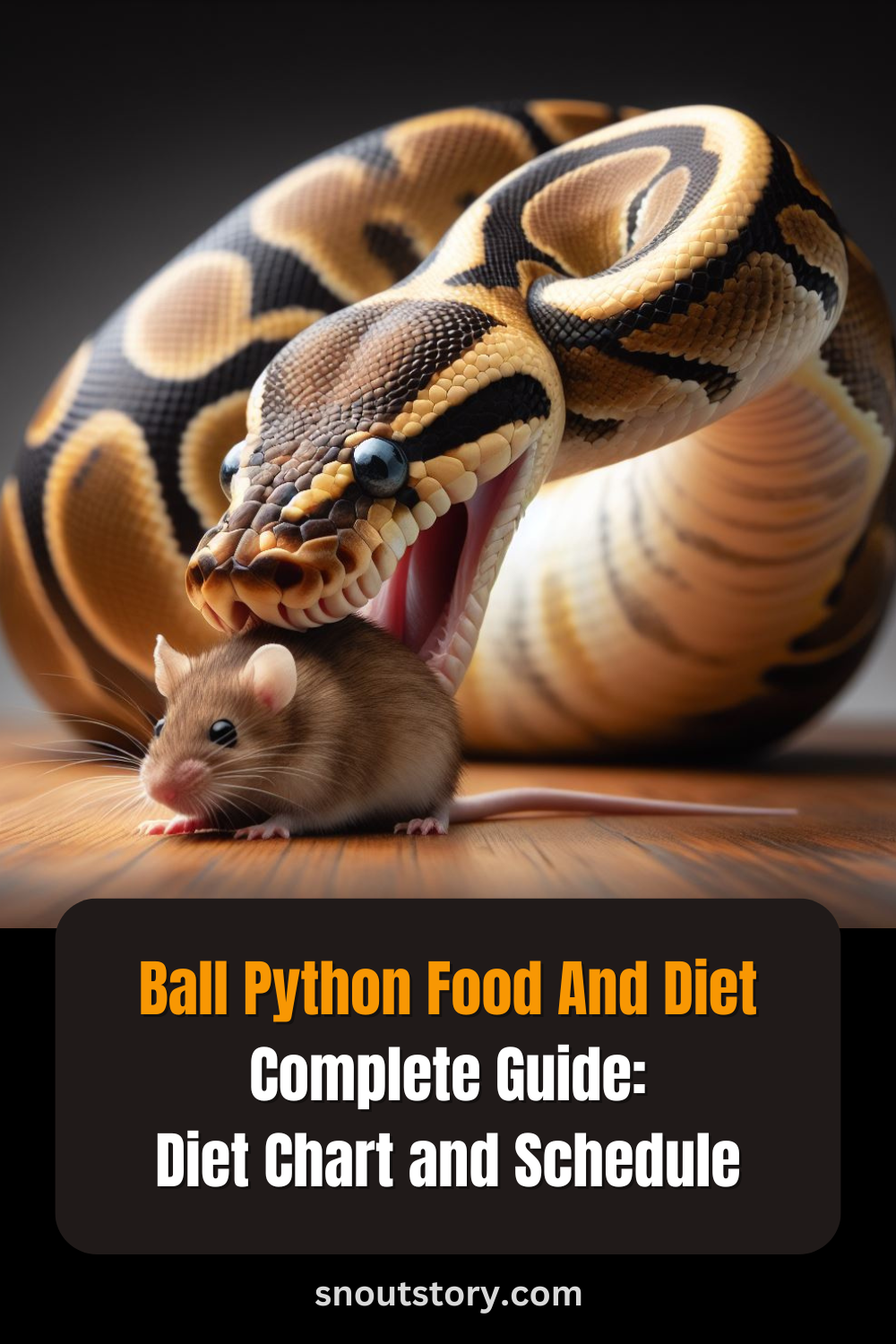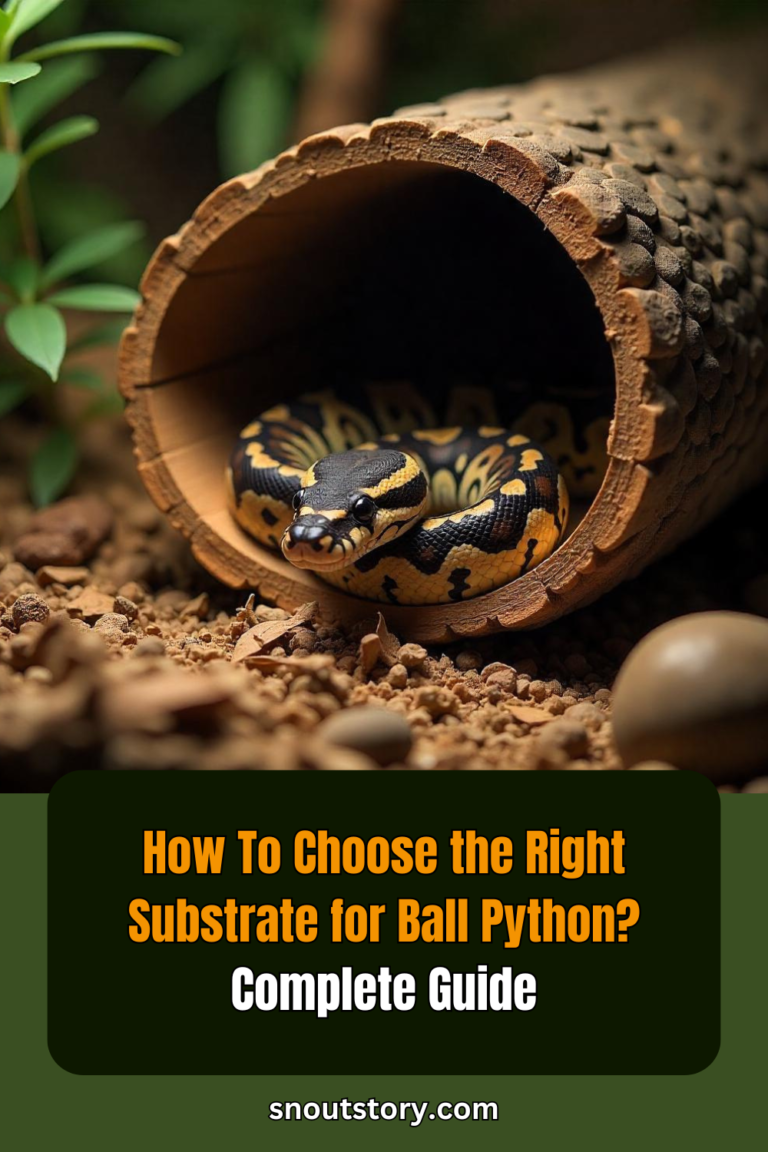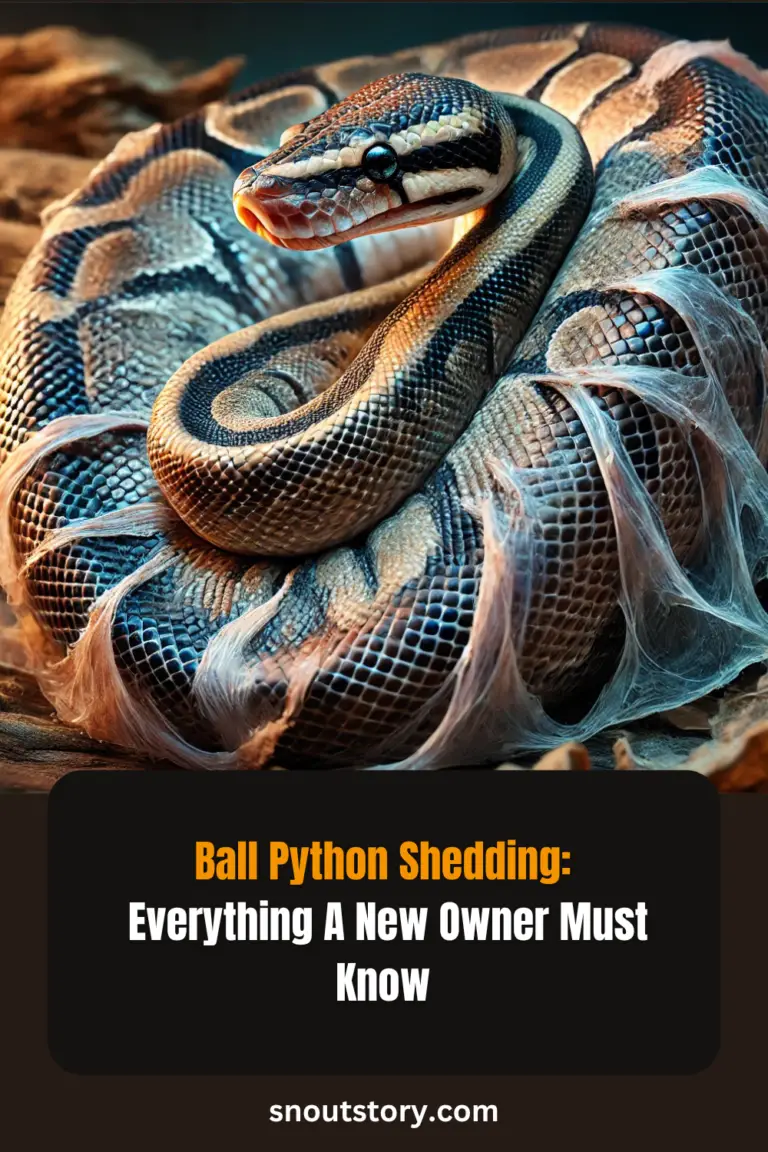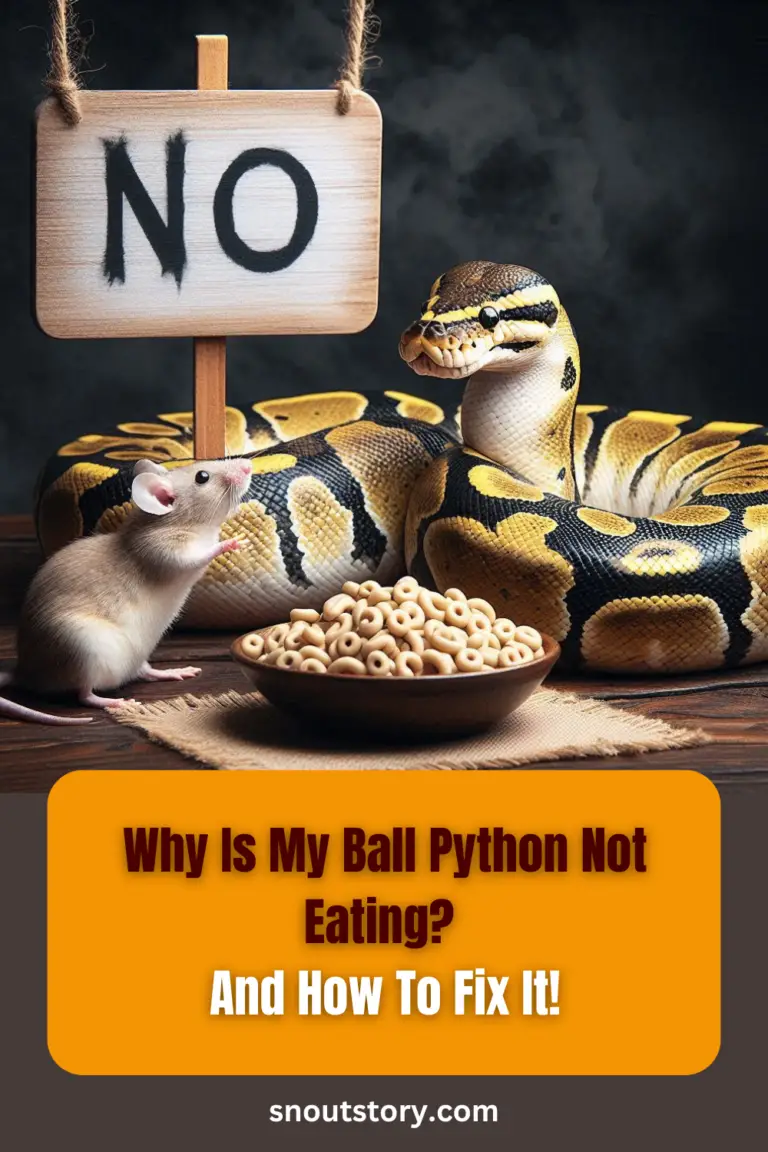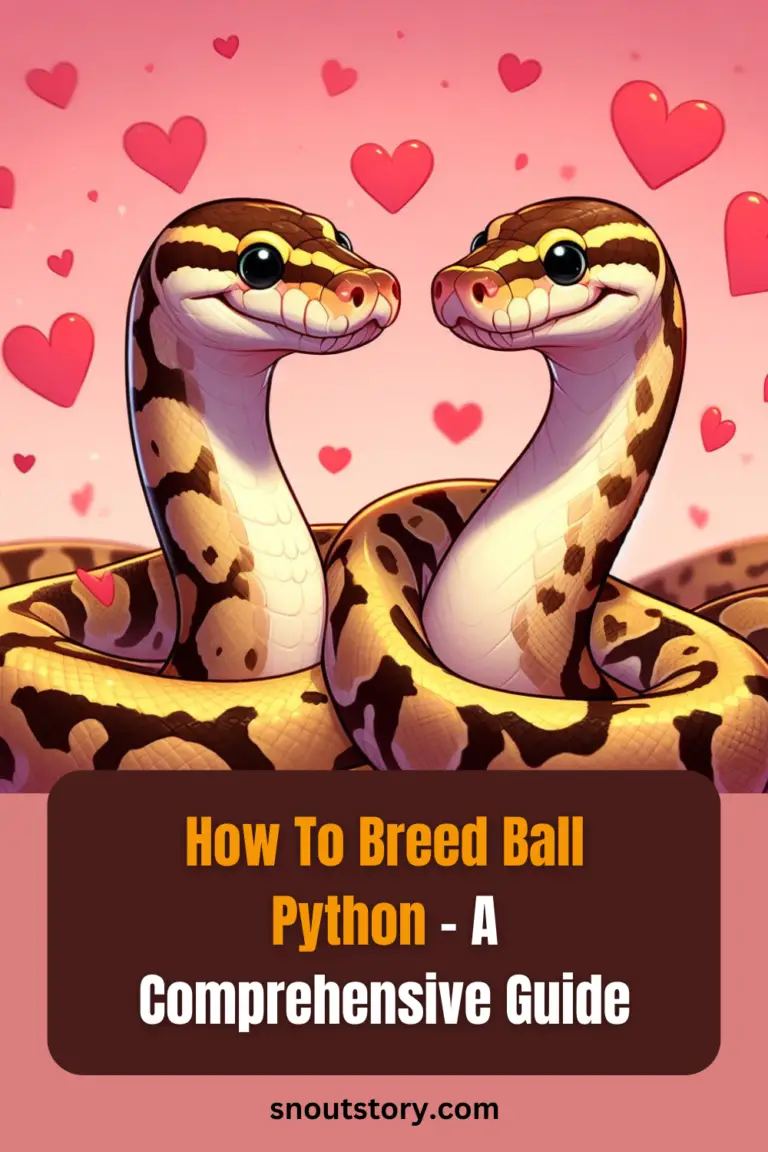Disclaimer
“This Blog is completely reader supported, for any purchase you make from affiliate links on this blog we earn a small commissions with no extra cost to you, which I use to feed my poor puppies 🥺”
Ball pythons, also known as royal pythons, are a popular species of pet snake. These fascinating creatures are known for their docile temperament and stunning appearance, making them a popular choice for snake owners.
However, providing proper care and nutrition is essential to keeping a ball python healthy and happy. In this article, we will provide a comprehensive guide to feeding ball pythons, including a detailed discussion of their natural diet, prey selection, feeding frequency, and more.
What Do Ball Pythons Eat in the Wild?
Ball pythons are native to West and Central Africa and are primarily found in savannas and forests. In the wild, they feed mainly on small mammals, such as rodents, birds, and reptiles. Ball pythons are ambush predators, meaning they will lie in wait for their prey before striking and constricting it. This type of hunting requires a lot of patience, as ball pythons can go weeks or even months without a meal.
In captivity, ball pythons can be fed a variety of prey items, including mice, rats, rabbits, and chicks. It is important to understand that ball pythons are not fast eaters, and it may take them several days to fully digest their food. This slow digestion rate is due to the fact that ball pythons have a low metabolism and do not need to eat as often as other species of snakes.
What to feed Pet Ball Pythons?
Choosing the Right Prey for Your Ball Python
When it comes to feeding your ball python, choosing the right prey is essential to ensure they are getting the nutrients they need. The size of the prey should be approximately the same diameter as the widest part of your snake’s body.
This will ensure that your snake is able to successfully constrict and swallow its food without any difficulties. It is also important to consider the age of your snake when choosing its diet. Juvenile ball pythons can be fed mice, while adult ball pythons typically require larger prey, such as rats, chicks or rabbits.
In addition to size, it is also important to consider the type of prey you are feeding your ball python. Rodents, such as mice and rats, are the most commonly fed prey items for ball pythons.
These prey items are high in protein and fat, which are essential nutrients for ball pythons. Rabbits and chicks can also be fed to ball pythons, but it is important to ensure that these prey items are appropriately sized for your snake.
Here are few animals Ball Pythons can eat as pets (Ball Python Diet chart):
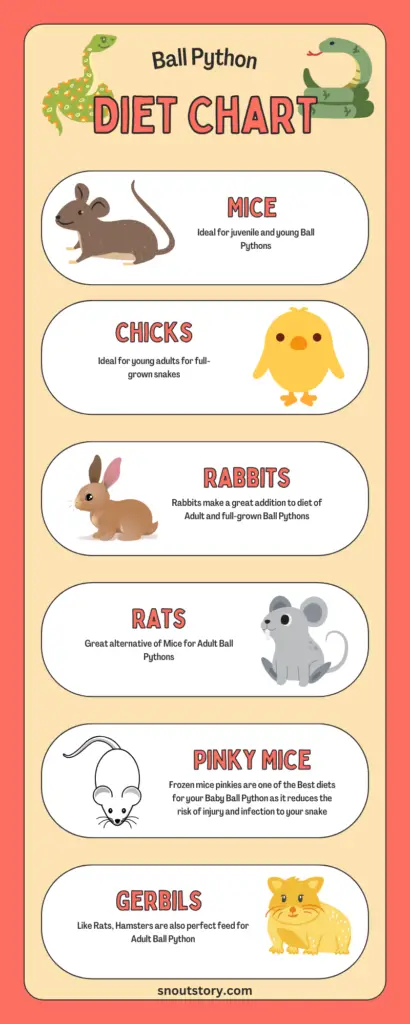
- Mice
- Rats
- Rodents
- Chicks
- Rabbits
- Gerbils
- Frozen pinkies
Also Read: Ball Python Bite – Does it Hurt?
Ball Python Feeding Frequency and Amounts
Ball pythons typically eat once a week, and their feeding schedule may change based on their growth rate and level of activity. It is important to observe your snake and make adjustments to its feeding schedule as needed.
Overfeeding can lead to obesity, which can cause serious health problems, such as liver and kidney damage, and decreased mobility. On the other hand, underfeeding can result in malnutrition and stunted growth.
When feeding your ball python, it is important to provide the right amount of food. Juvenile ball pythons can typically be fed one mouse per feeding, while adult ball pythons may require up to three or four mice or one rat or rabbit.
It is important to monitor your snake’s weight and adjust its feeding amount as needed. You can do this by weighing your snake before and after feeding, and keeping a record of its weight over time. This will help you determine the appropriate feeding amount for your snake.
Ball Python Feeding Schedule And Chart
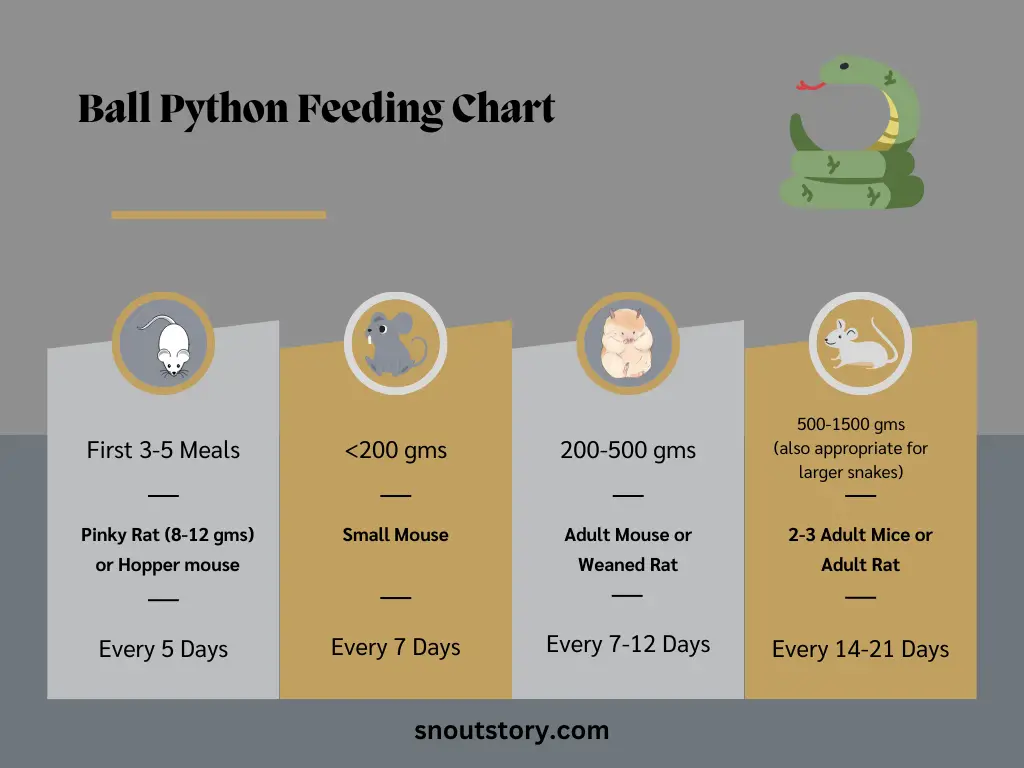
- For newborn snakes, the first 3-5 meals should be fed at the interval of every 5 days. Pinky rats and hopper mice make perfect feed for newborns.
MiceDirect Frozen Mice Combo Pack of Small Pinkies & Pinkies Feeder Mice

- Ball Pythons weighing more than 200gms should be fed at the internal of 7 days. Rat fuzzy or small mice make right feed for these snakes.
At this stage you need to be utmost aware about what you feed, make sure food it not too big nor too small
MiceDirect 15 Frozen Mice Hopper Feeders Snake Food

- For snakes weighing 200 to 500gms, food should be fed after every 7-10 days. At this stage you can feed your snake with an adult mouse or weaned rat.
- Snakes weighing around 500-1500gms and more should be fed after every 14-21 days. Adult Ball Pythons can eat 2-3 adult mice or an adult rat at a time.
This will be perfect size and diet if you have an adult Ball Python:
Frozen Large Adult Feeder Mice Food for Adult Ball Pythons

Should you feed Live or Frozen Prey to your Ball Python?
Ball pythons can be fed live or frozen prey, and both options have their pros and cons. Live prey provides a more natural feeding experience for your snake, as it is able to hunt and constrict its food. However, live prey can pose a risk to your snake, as it may attack or bite your pet. In addition, live prey can also carry diseases and parasites that can be transmitted to your snake.
Frozen prey, on the other hand, eliminates the risk of injury to your snake and the transmission of diseases and parasites. Frozen prey is also convenient and easy to store, as it can be purchased in bulk and kept in the freezer for future feedings. When feeding your snake frozen prey, it is important to thaw it completely before offering it to your pet. This can be done by placing the prey in the refrigerator overnight, or by using a bowl of warm water to thaw it more quickly.
Providing Proper Hydration
In addition to providing proper nutrition, it is also important to ensure that your ball python is properly hydrated. Ball pythons can be offered water in a shallow dish, and it is important to change the water regularly to prevent the growth of bacteria. It is also a good idea to mist your snake’s enclosure once a week to help increase humidity levels and provide additional hydration. Having a water will also boost overall aesthetic appeal of your enclosure and act as a mini-pond helping your ball python take occasional baths and improve you enclosure aesthetics. You can consider the one given below, it looks very natural and blends in perfectly with the overall setup:
Fluker’s Food and Water Reptile Corner Bowl

Summary
If you found our content helpful and valuable, you can support us by making any of your purchases (even products other than recommended in the blog) from our affiliate links (Ofc with no extra cost to you😉).
In conclusion, feeding your ball python with a proper diet is an essential part of providing proper care and keeping your pet healthy and happy. By understanding their natural diet, choosing the right prey, and providing the right amount of food, you can ensure that your snake receives the proper nutrition it needs. It is also important to ensure that your snake is properly hydrated and to monitor its weight and feeding schedule. With a little bit of care and attention, you can provide your ball python with a long, happy, and healthy life.
Recommended
How to Create a Bioactive Ball Python Enclosure: Detailed Guide
12 Ball Python Enclosure Setup Ideas For Realistic Habitat
How To Choose the Right Substrate for Ball Python? Complete Guide
Ball Python Shedding: Everything A New Owner Must Know
Why Is My Ball Python Not Eating? And How To Fix It!
How To Breed Ball Python – A Comprehensive Guide
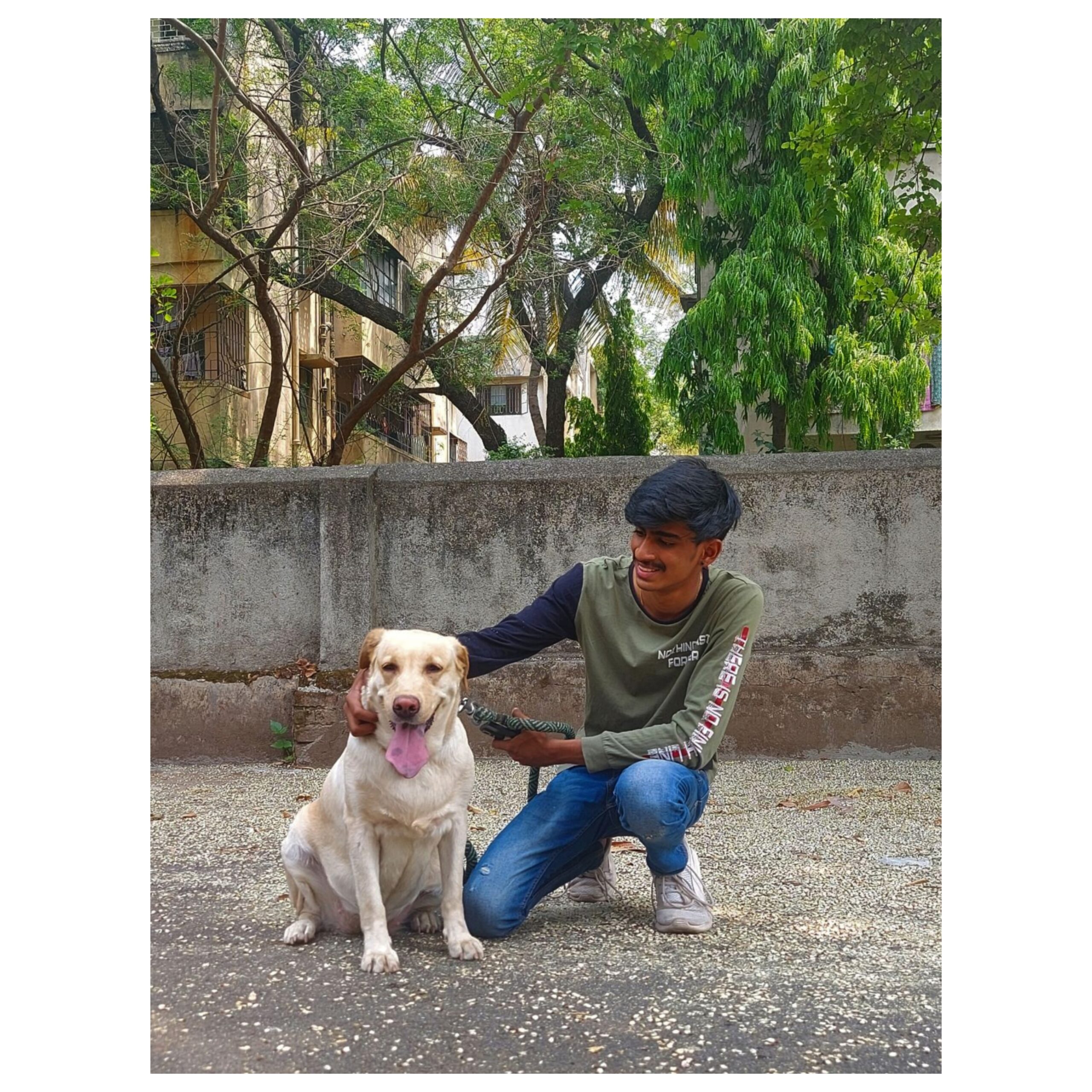
Vedant Narvekar is an experienced digital marketing expert with a profound love for nature and animals. With a career rooted in leveraging online platforms to drive engagement and promote meaningful causes, Vedant’s passion for animals inspired him to start Snout Story—a blog dedicated to educating people about pet keeping and sharing proper knowledge about caring for animals. Drawing on his expertise in digital marketing, Vedant utilizes his platform to advocate for responsible pet ownership, providing valuable insights on pet care, training, nutrition, and more. Through Snout Story, Vedant aims to empower pet lovers with the information they need to provide the best possible care for their furry companions, while also fostering a deeper appreciation for the natural world and the creatures that inhabit it.

